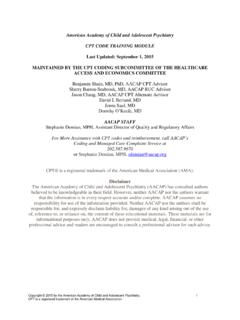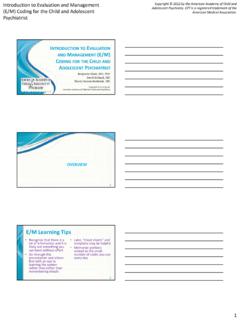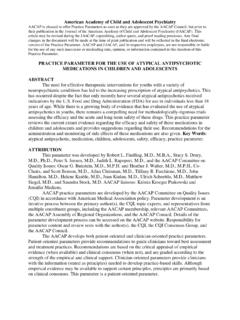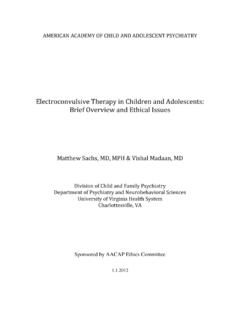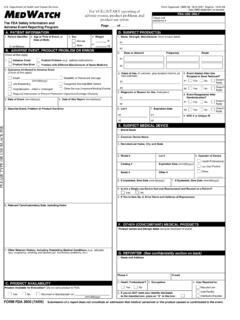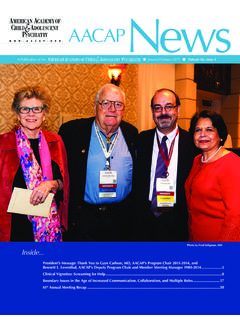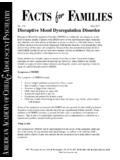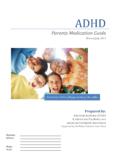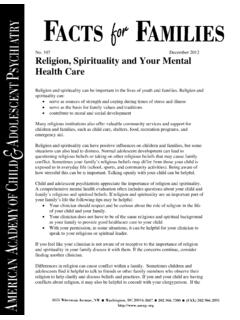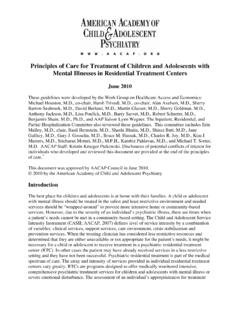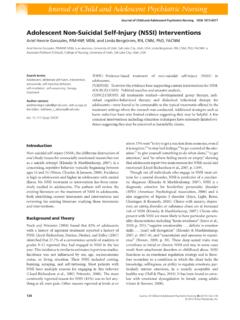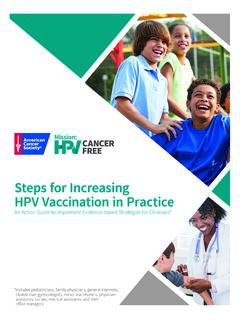Transcription of Recommendations about the Use of Psychotropic Medications ...
1 2015 aacap . Recommendations about the Use of Psychotropic Medications for Children and Adolescents Involved in child -Serving Systems Executive Summary The american academy of child and adolescent Psychiatry ( aacap ) recognizes that there are current concerns about Psychotropic prescribing practices for children and adolescents, especially involving those in foster care. This document is intended to promote safety and quality in mental health treatment, with particular attention to the appropriate use of Psychotropic medication in children and adolescents in child -serving systems. Our Recommendations apply to all children and adolescents, including those living in their family homes, foster care, and other out-of-home settings. The decision to prescribe Psychotropic medication is integrally linked to the entire process of mental health treatment. An overarching principle is that the use of Psychotropic medication for children and adolescents should be part of holistic and collaborative mental health treatment.
2 This involves a commitment to the biopsychosocial perspective, trauma-informed care principles, and system of care values and principles. Of particular importance is the need for prescribers and other professionals to provide care that is individualized, family-driven, and youth-guided, with recognition that collaborating with children and families is both an ethical and a pragmatic imperative. Such quality rests not only on important technical skills but also on strong therapeutic relationships, a biopsychosocial perspective (Engel, 1980), and commitment to both trauma-informed care principles (Fallot, 2009) and system of care principles (Pires, 2011; Pires, 2014). When indicated, Psychotropic medication needs to be prescribed according to the practice parameter developed by aacap in 2009, and its use should be monitored by the prescriber and family/guardian and subject to oversight by relevant child -serving systems. Psychotropic medication should be provided in conjunction with evidence-based psychosocial interventions, except in the most uncomplicated situations when the use of medication alone may be considered.
3 States and communities need to have a clearly delineated process for medication monitoring and oversight because of concerning trends in the prescription of Psychotropic medication. These include large variation in prescribing practices, increased use of these Medications , particularly for youth in foster care, potential adverse effects, and cost implications. At the same time, given the pressing needs of many youth with complex psychiatric presentations, careful and judicious use of medication may be 2. appropriate despite limited empiric support. In light of these challenges, additional research into the effectiveness of psychosocial and Psychotropic interventions is urgently needed. The Recommendations in this document fall into three general categories: clinical practice; Psychotropic medication monitoring and oversight; and research. Clinical Practice 1. Prescribers of Psychotropic medication for children and adolescents, and others working with them and their families should adhere to a developmentally-informed biopsychosocial approach, trauma-informed care principles, and system of care principles.
4 2. When Psychotropic medication is being considered, children and adolescents should receive a comprehensive behavioral health assessment. 3. Prescribers of Psychotropic medication should actively engage and collaborate with children and adolescents and their families when they are referred for potential use of such medication. 4. Prescribers should actively engage and collaborate with other professionals and systems involved with the child and family. 5. All youth with complex behavioral needs, including youth in foster care, should receive a combination of evidence-based psychosocial interventions and Psychotropic medication when indicated, not just Psychotropic medication alone. 6. Clinical guidelines identified in the 2009 aacap Practice Parameter, Prescribing Psychotropic Medication to Children should be implemented. 7. Prescribers should promote awareness of potential adverse effects and consistently monitor for such side effects over time. Psychotropic Medication Monitoring and Oversight 8.
5 Non-physician professionals working with youth should have knowledge of the guidelines in aacap publications and other resource documents relevant to the use of Psychotropic medication with youth. 9. Mental health agencies, child welfare, Medicaid agencies, and managed care organizations should collaborate to create systems to monitor, review, and inform practice patterns with Psychotropic Medications . 10. States and local agencies serving children in foster care should use the Best Principle Guideline in the 2005 aacap Position Statement as the framework for developing formal medication monitoring and oversight programs. 3. 11. Consultation programs should involve child and adolescents psychiatrists, who can offer technical assistance, second opinions, and case review when indicated. 12. Monitoring methods should entail a combination of approaches that include review of aggregate data on prescribing patterns, chart audits, and tracking of specific red flag markers.
6 13. child and adolescent psychiatrists should participate in the development of monitoring and oversight standards in their state and community, and involved systems should actively support their involvement. 14. Psychotropic medication monitoring and oversight efforts should involve collaboration among state and local agencies as well as managed care organizations. 15. Systemic oversight of Psychotropic medication prescribing should be pursued in a collegial manner that promotes the use of evidenced-informed practice. 16. Systems for medication review and for the approval or denial of Psychotropic medication requests should be streamlined and efficient, to avoid unnecessary treatment delay or provider burden. 17. All stakeholders and child -serving systems responsible for youth with complex mental health needs should advocate for increased availability of evidence-based psychosocial interventions by qualified staff. Research 18. Clinical research is necessary to investigate the most effective approaches to prevention, early intervention, and treatment of complex behavioral health needs of children and adolescents.
7 aacap is committed to promoting prescribing practices that are safe and of high quality, and oversight and monitoring practices based on best practices that promote collaboration among systems and professionals. child and adolescent psychiatrists can offer support, leadership and expertise with these important efforts. 4. 2015 aacap . Recommendations about the Use of Psychotropic Medications for Children and Adolescents Involved in child -Serving Systems Introduction The american academy of child and adolescent Psychiatry ( aacap ) recognizes that there are current concerns about Psychotropic prescribing practices for children and adolescents, especially involving those in foster care. This document is intended to promote safety and quality in mental health treatment, with particular attention to the appropriate use of Psychotropic medication in children and adolescents in child -serving systems. Our Recommendations apply to all children and adolescents, including those living in their family homes, foster care, and other out-of-home settings.
8 An overarching principle is that the use of Psychotropic medication for children and adolescents should be part of holistic and collaborative mental health treatment. Such quality rests not only on important technical skills but also on strong therapeutic relationships, a biopsychosocial perspective[1], and commitment to both trauma-informed care principles [2] and system of care principles [3, 4]. In order to address the appropriate use of Psychotropic medication for children and adolescents, aacap has developed a number of resources. These include practice parameters, policy statements, and other documents that address related the following topics of relevance: 2003 aacap Policy Statement on Psychiatric Diagnostic Evaluations [5]. 1997 aacap Practice Parameter for the Psychiatric Assessment of Children and Adolescents [6] (Currently being updated). 1997 aacap Practice Parameter for the Psychiatric Assessment of Infants and Toddlers [7] (Scheduled to be update).
9 Treatment in a System of Care 2013 aacap Practice Parameter for Cultural Competence in child and adolescent Psychiatric Practice [8]. 2012 A Guide for Community child Serving Agencies on Psychotropic Medications for Children and Adolescents (2012 document developed in response to a request by the Center for Mental Health Services (CMHS). 5. within the federal Substance Abuse and Mental Health Services Administration (SAMHSA).[9]. 2007 aacap Practice Parameter on child and adolescent Mental Health Care in Community Systems of Care [10]. Collaboration 2011 aacap Policy Statement on Medical Homes for Children and Adolescents with Mental, Developmental, and Substance Abuse Disorders [11]. 2009 aacap Policy Statement on Family and Youth Participation in Clinical Decision-Making [12]. 2008 aacap Policy Statement on Collaboration with Pediatric Medical Professionals [13]. 2004 aacap Policy Statement on child and adolescent Psychiatrists Role in Collaboration with Other Mental Health Professionals [14].)
10 Foster Care 2015 aacap Practice Parameter for the Assessment and Management of Youth Involved With the child Welfare System [15]. 2002 aacap / child Welfare League of America (CWLA) Foster Care Mental Health Subcommittee [16]. 2003 aacap /CWLA Policy Statement on Mental Health Substance Abuse Use Screening/Assessment of Children in Foster Care [17]. 2001 aacap Policy Statement on Psychiatric Care for Children in the Foster Care System [18]. Prescribing Practices 2011 aacap Practice Parameter for the Use of Atypical Antipsychotic Medications in Children and Adolescents [19]. 2009 aacap Practice Parameter of the Use of Psychotropic Medication to Children [20]. 2001 aacap Policy Statement on Prescribing Psychoactive Medications for Children and Adolescents [21]. 2006 aacap Policy Statement on Evidence Based Practice [22]. 2005 aacap Position Statement on Oversight of Psychotropic Medication Use for Children in State Custody: A Best Principles Guideline [23]. Additional Documents Government Accountability Office (GAO) documents drawing from aacap 's 2005 Position Statement on Oversight of Psychotropic Medication for Children in State Custody [23].
